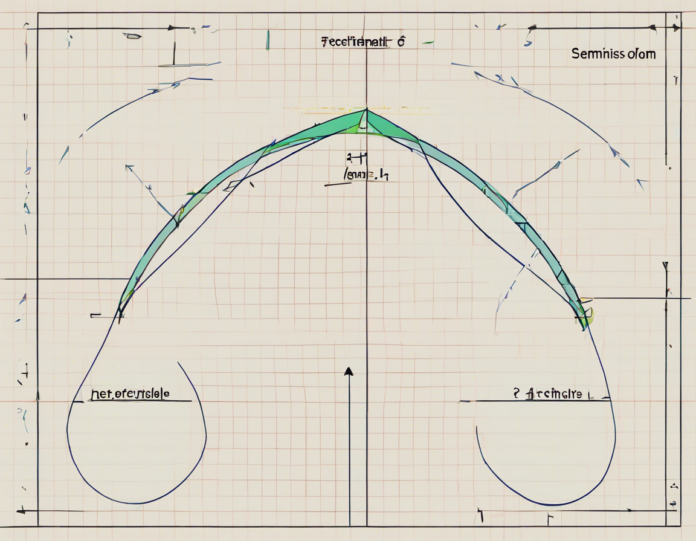When it comes to geometric shapes, semicircles hold a significant place due to their relevance in various mathematical calculations and real-world applications. A semicircle is half of a circle, formed by taking a diameter and connecting the endpoints with a curved line. Understanding how to calculate the perimeter of a semicircle is essential for fields such as architecture, engineering, physics, and mathematics. In this comprehensive guide, we will delve into the step-by-step process of calculating the perimeter of a semicircle, exploring the relevant formulas, concepts, and examples along the way.
Understanding the Basics:
Before we jump into calculating the perimeter of a semicircle, let’s familiarize ourselves with some fundamental concepts related to circles and semicircles.
Circle vs. Semicircle:
-
Circle: A circle is a closed shape where all points are equidistant from a central point, known as the center. It consists of an infinite number of points on a plane that are at a fixed distance, known as the radius, from the center.
-
Semicircle: A semicircle is exactly half of a circle, divided by a diameter. It has one straight edge and one curved edge, with the curved edge being a semicircular arc.
Key Terminology:
-
Radius (r): The distance from the center of a circle or semicircle to any point on its circumference.
-
Diameter (d): The straight line passing through the center of a circle or semicircle, connecting two points on the circumference.
-
Circumference: The perimeter of a circle or semicircle, representing the total length of its boundary.
Now that we have a clear understanding of the basic concepts, let’s move on to the specific steps involved in calculating the perimeter of a semicircle.
Calculating the Perimeter of a Semicircle:
The perimeter of a semicircle includes both the curved section (half of the circumference of a full circle) and the diameter. To find the perimeter, we need to consider both these components and sum their lengths. The formula to calculate the perimeter of a semicircle can be derived from the formulas for the circumference of a circle and the perimeter of a full circle.
Formula for the Perimeter of a Semicircle:
The formula to calculate the perimeter (P) of a semicircle with radius r is:
[ P = \frac{1}{2} \times (2 \times \pi \times r) + 2 \times r ]
Simplifying the formula, we get:
[ P = \pi \times r + 2 \times r ]
Step-by-Step Calculation Process:
Let’s break down the calculation process into simple steps for better understanding and application.
Step 1: Identify the Radius (r)
The first step is to determine the radius of the semicircle. This can be given in the problem statement or measured if you are dealing with a real-life scenario.
Step 2: Calculate the Circumference of the Full Circle
Since a semicircle is half of a circle, we first need to find the circumference (C) of the full circle using the formula:
[ C = 2 \times \pi \times r ]
Step 3: Find the Perimeter of the Semicircle
Once we have the circumference of the full circle, we can calculate the perimeter of the semicircle using the formula:
[ P = \frac{1}{2} \times C + 2 \times r ]
Substitute the value of C in the above formula to get the final perimeter of the semicircle.
Example Calculation:
Let’s consider an example to put the calculation process into perspective:
Example: Find the perimeter of a semicircle with a radius of 5 cm.
Step 1: Radius (r) = 5 cm
Step 2: Circumference of the full circle: ( C = 2 \times \pi \times r = 2 \times \pi \times 5 ) cm
Step 3: Perimeter of the semicircle: [ P = \frac{1}{2} \times (2 \times \pi \times 5) + 2 \times 5 ] cm
Solving the above expression would give you the perimeter of the given semicircle in this specific example.
Applications and Significance:
Understanding how to calculate the perimeter of a semicircle has practical applications in various fields. Engineers use this knowledge in designing curved structures, architects utilize it in creating arched windows and doors, and mathematicians rely on it in geometric calculations. Moreover, having a grasp of perimeter calculations enhances problem-solving skills and lays the foundation for more complex mathematical concepts.
Common Challenges and Tips:
While calculating the perimeter of a semicircle, individuals may encounter certain challenges. Here are some common issues and tips to overcome them:
-
Incorrect radius measurement: Ensure you have the correct radius value to avoid miscalculations.
-
Forgetting to halve the circumference: Remember that a semicircle involves half of the circumference of a full circle.
-
Misinterpreting the formula: Understand each component of the formula and its significance in the calculation.
By paying attention to these common challenges and tips, you can streamline your calculation process and arrive at accurate results efficiently.
Frequently Asked Questions (FAQs):
- What is the difference between a circle and a semicircle?
-
A circle is a complete shape with no openings, while a semicircle is exactly half of a circle, formed by dividing it with a diameter.
-
Can the perimeter of a semicircle be calculated if only the diameter is given?
-
Yes, you can calculate the radius from the given diameter by dividing it by 2, and then proceed to find the perimeter using the derived radius.
-
In which units is the perimeter of a semicircle typically measured?
-
The perimeter of a semicircle is usually measured in units such as centimeters (cm), meters (m), or any other unit of length.
-
Why is it important to know how to calculate the perimeter of a semicircle?
-
Understanding the perimeter of a semicircle is essential for various mathematical, engineering, and architectural applications that involve curved structures.
-
Can the perimeter of a semicircle be expressed as a function of the radius only?
- Yes, the formula for the perimeter of a semicircle (( P = \pi \times r + 2 \times r )) is in terms of the radius only, making it convenient for calculations.
In conclusion, mastering the calculation of the perimeter of a semicircle is a valuable skill that can be applied across diverse disciplines. By following the steps outlined in this guide, individuals can enhance their problem-solving abilities and mathematical proficiency, paving the way for a deeper understanding of geometric concepts and their real-world implications.

